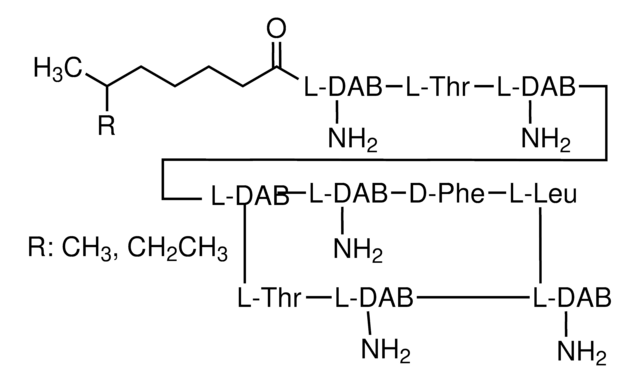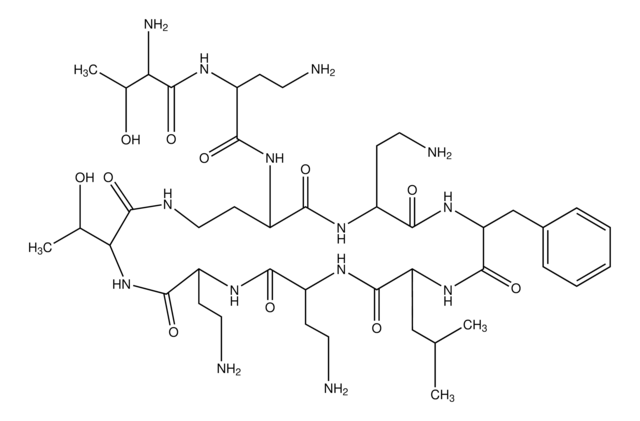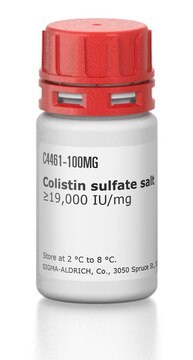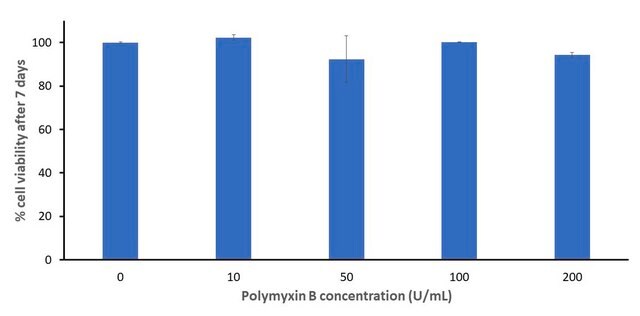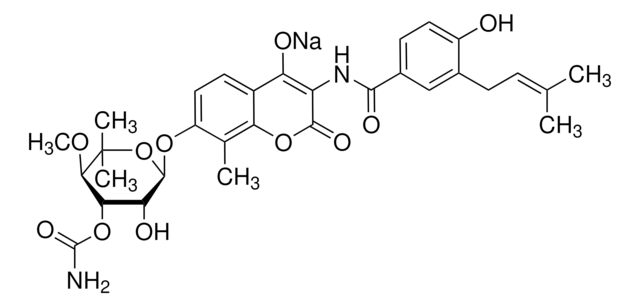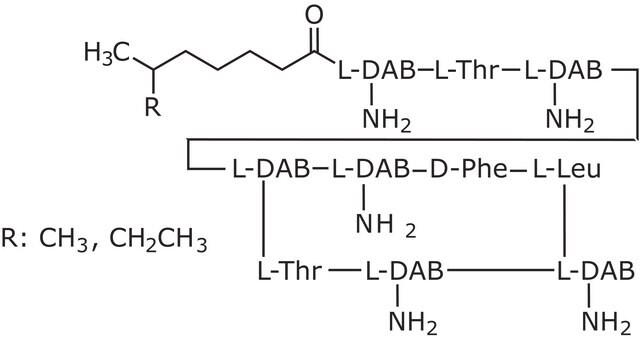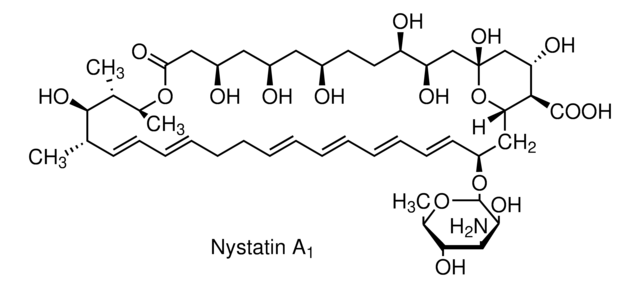Kluczowe dokumenty
P4932
Polymyxin B sulfate salt
powder, non-animal origin, suitable for cell culture, BioReagent
Synonim(y):
Polymixin, Polymixin B, Polymixin B sulfate
About This Item
Polecane produkty
product name
Polymyxin B sulfate salt, powder, BioReagent, suitable for cell culture
linia produktu
BioReagent
Poziom jakości
Postać
powder
siła działania
≥6,000 USP units per mg
metody
cell culture | mammalian: suitable
spektrum działania antybiotyku
Gram-negative bacteria
Tryb działania
cell membrane | interferes
temp. przechowywania
2-8°C
ciąg SMILES
O=C(C(NC(C(CCN)NC(CCCCC(C)CC)=O)=O)C(C)O)NC(CCN)C(NC(CCNC(C(NC(C(NC(C(CCN)N1)=O)CCN)=O)C(O)C)=O)C(NC(CCN)C(NC(CC2=CC=CC=C2)C(NC(CC(C)C)C1=O)=O)=O)=O)=O.O=S(O)(O)=O
InChI
1S/C48H82N16O13.H2O4S/c1-27(2)24-37-47(76)59-32(11-19-52)41(70)56-31(10-18-51)43(72)61-35(14-22-65)39(68)54-21-13-34(45(74)57-33(12-20-53)44(73)64-38(48(77)63-37)25-28-6-4-3-5-7-28)60-42(71)30(9-17-50)58-46(75)36(15-23-66)62-40(69)29(8-16-49)55-26-67;1-5(2,3)4/h3-7,26-27,29-38,65-66H,8-25,49-53H2,1-2H3,(H,54,68)(H,55,67)(H,56,70)(H,57,74)(H,58,75)(H,59,76)(H,60,71)(H,61,72)(H,62,69)(H,63,77)(H,64,73);(H2,1,2,3,4)
Klucz InChI
HNDFYNOVSOOGDU-UHFFFAOYSA-N
Szukasz podobnych produktów? Odwiedź Przewodnik dotyczący porównywania produktów
Opis ogólny
Chemical structure: peptide
Zastosowanie
- for the treatment of BAC-1.2F5 murine macrophages as an LPS (lipopolysaccharide) inhibitor
- as positive and negative control during microbicidal concentration (MCC) assay
Działania biochem./fizjol.
Antimicrobial spectrum: Has bactericidal action on most gram-negative bacilli††, including E. Coli and on most fungi and gram-positive bacteria.
Przestroga
Uwaga dotycząca przygotowania
Inne uwagi
Hasło ostrzegawcze
Warning
Zwroty wskazujące rodzaj zagrożenia
Zwroty wskazujące środki ostrożności
Klasyfikacja zagrożeń
Acute Tox. 4 Oral
Kod klasy składowania
11 - Combustible Solids
Klasa zagrożenia wodnego (WGK)
WGK 3
Temperatura zapłonu (°F)
Not applicable
Temperatura zapłonu (°C)
Not applicable
Środki ochrony indywidualnej
dust mask type N95 (US), Eyeshields, Gloves
Certyfikaty analizy (CoA)
Poszukaj Certyfikaty analizy (CoA), wpisując numer partii/serii produktów. Numery serii i partii można znaleźć na etykiecie produktu po słowach „seria” lub „partia”.
Masz już ten produkt?
Dokumenty związane z niedawno zakupionymi produktami zostały zamieszczone w Bibliotece dokumentów.
Klienci oglądali również te produkty
Nasz zespół naukowców ma doświadczenie we wszystkich obszarach badań, w tym w naukach przyrodniczych, materiałoznawstwie, syntezie chemicznej, chromatografii, analityce i wielu innych dziedzinach.
Skontaktuj się z zespołem ds. pomocy technicznej